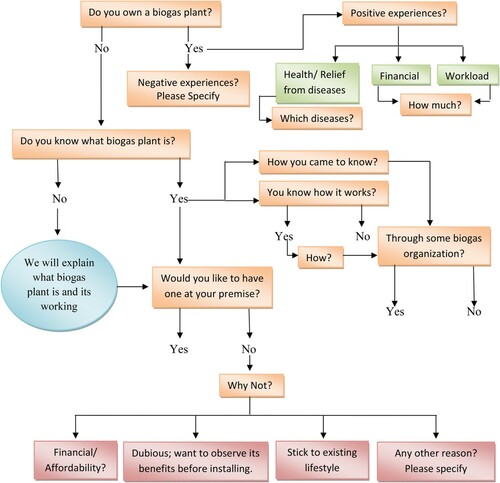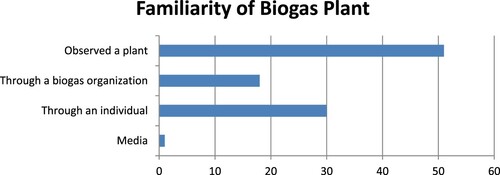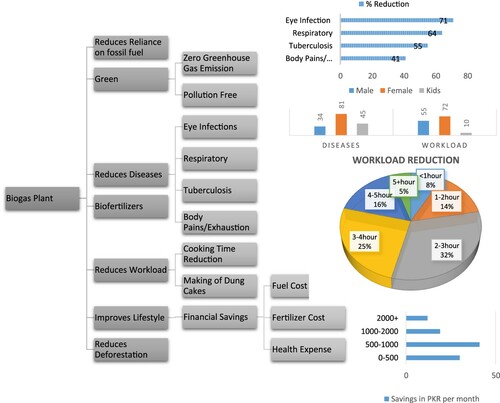ABSTRACT
The energy crisis has pushed Pakistan way down the economic rankings. More than 70% the total population resides in rural regions. The energy crisis has crippled the lifestyle of the rural class (RC) in many aspects. For rural Pakistan, the energy scarcity, a hurdle in sustainable development, can be eliminated by biogas. Almost every rural family is associated with agriculture and owns livestock animals, therefore self-sufficient in biogas plant’s fuel. Fuel abundance and favourable climatic conditions make energy extraction from biomass facile and fruitful; still there are many reasons that RC is dumped in the energy crisis. In this paper, a survey is conducted in villages of Pakistan to discover the reasons due to which domestic biogas plants have not yet gained their due importance. Institutional, financial, awry planning and social barriers are highlighted at the grass root level in the development of biogas technology in rural Pakistan. In contrast, villages where biogas plants are present, the survey analysis revealed prosperity rendered through savings, reduction in diseases and workload. The paper concludes with an emphasis on the requirement of concrete and comprehensive policy that is capable to deal with the barriers in the route of biogas technology.
| List of abbreviations | ||
| RC | = | Rural Class |
| HEC | = | Higher Education Commission |
| NEPRA | = | National Electric Power Regulatory Authority |
| GW | = | Giga Watt |
| UNDP | = | United Nations Development Programme |
| NDO | = | Netherland Development Organisation |
| PCRET | = | Pakistan Council of Renewable Energy Technologies |
| AEDB | = | Alternate Energy Development Board |
| PARC | = | Pakistan Agriculture Research Council |
| NRSP | = | National Rural Support Programme |
| PDBP | = | Pakistan Domestic Biogas Programme |
| NBP | = | National Biogas Programme |
| UAF | = | University of Agriculture Faisalabad |
| MUET | = | Mehran University of Engineering and Technology |
| UET | = | University of Engineering and Technology |
| PU | = | Punjab University |
| CIIT | = | COMSATS Institute of Information Technology |
| UAP | = | University of Agriculture Peshawar |
| NED | = | Nadirshaw Eduljee Dinshaw |
| UOB | = | University of Bahawalpur |
| UOG | = | University of Gujarat |
| BZU | = | Bahauddin Zakariya University |
Highlights
Pakistan’s potential of domestic biogas in battling rural energy crisis
Organisational structure for biogas promotion
Acceptance, willingness and barriers in domestic biogas development
Requirement of firm and comprehensive policy for biogas promotion
1. Introduction
The increase in population brings many challenges for a nation (Pereira Citation2017). Modern societies are only a dream without sufficient energy (Latief and Lefen Citation2019). Countries that foresee the issues connected with population increase save themselves from the crisis of any sort. Unfortunately, those who keep on going and live in the present with no future planning get dumped into crisis. Although it is taught in the very basic curriculum around the world that energy can neither be created nor destroyed; however, it can be converted from one form to another (Farhodovna and Abdishukurovna Citation2021). Even then we blindfold ourselves and keep on wasting the energy without devising means of converting energy in a utilisable form. Energy is the basic constituent in the economic standing of a country (Uribe-Toril et al. Citation2019; Li et al. Citation2019; Mittlefehldt Citation2018). The economic development of a nation can be determined from the usage to availability ratio of the energy of every individual. Energy is a variable that is present in every individual’s equation. And on a national level, mathematics fails if this variable does not hold an adequate value.
The world’s fossil fuel reserves are on the verge of depletion (Kalair et al. Citation2021). Besides this, they are a threat to the environment as well. The renewable energy resources are a sigh of relief in this regard as these reduce reliance on fossil fuels. For being environment-friendly and sustainable, these resources are preferred around the globe. Due to rising awareness, the renewable energy resources consume 21.8% of the world’s energy (https://www.iea.org). Studies have proved that renewable energy sources are the backbone of every nation’s socio-economic development. The developing countries have modified their energy mix to accommodate a substantial portion of renewable energy. They are increasing energy production through renewable resources at a very fast pace to assure energy security and economic development (Kim, Park, and Kim Citation2017; Urmee and Md Citation2016; Wang et al. Citation2018; Gökgöz and Güvercin Citation2018; Latif et al. Citation2020).
Energy crisis has struck many countries of the world. Pakistan’s scenario is among the darkest ones (Kanwal, Khan, and Rauf Citation2020; Arshad and Ali Citation2017; Idrees Citation2020; Kamran, Fazal, and Mudassar Citation2020; Gelani, Dastgeer, Umar, et al. Citation2018; Mughees et al. Citation2020). The population growth and utilisation of fossil fuels with no proper planning have brought a severe energy crisis. The energy mix of Pakistan, depicted in , reveals the dependence of Pakistan on oil and gas. The authorities have failed to cut down the brake-free usage of fossil fuels, bringing the resources to deplete and, in turn, the country to a crisis. To fufil the need of energy, Pakistan has to import billions of dollars of fossil fuels annually (CitationNEPRA). The forests are cut down for wood fuel to meet energy demands. The annual volume of wood fuel makes millions of cubic metre. For a developing country, the energy mix should be at a balance between renewable and conventional resources. The energy mix of Pakistan has a high proportion of natural gas and oil (Anwar Citation2016). Both are assumed to be depleted in the next 10 years (Irfan et al. Citation2019). Millions of tons of fossil fuel import prognosticate energy crisis and showcase economic disaster in the form of import bill paid as electricity charges by end-consumers. The energy sector is poorly managed making the infrastructure inefficient and ineffective. Pakistan invests 60% of its foreign exchange on oil imports. Moreover, the oil and gas-based energy extraction is efficient but brings hazardous effects on the environment and therefore the health of natives. Every year, thousands of patients are reported to have respiratory diseases in Pakistan due to polluted air by burning fossil fuels. The carbon-constrained environment has caused considerable temperature rise at an alarming rate (Haider et al. Citation2017).
Figure 1. Energy mix of Pakistan (Ahmad et al. Citation2016).
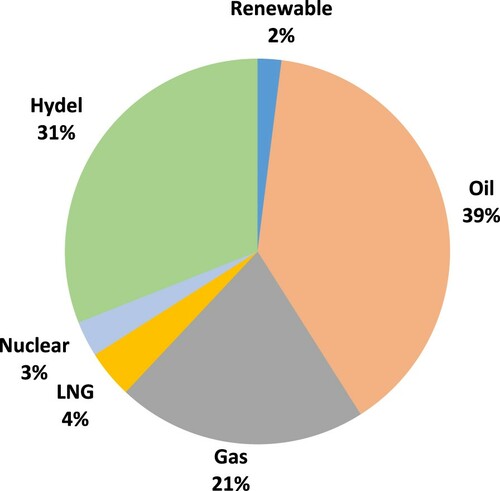
Hours of load-shedding every day is a proof to strengthening the energy crisis of Pakistan. Load-shedding has led to challenges such as unemployment, reduced production and exports, thereby causing a threat to socio-economic development. More than 70% of the population residing in rural regions is without electricity for three-fourth part of the day. The urban community, including the upper and upper middle class, can, however, meet their energy requirements, but unfortunately through wasteful means, thereby imposing further burden on national energy grid. They install Uninterruptible Power Supply (UPS) that is a threat to power system quality and economy (Arshad and Ali Citation2017) or generators that utilise gasoline which is already very limited. In fact, there is no balance in the situation of Pakistan. Those, who are rich can benefit, with their money killing the right of those who cannot afford.
The rural community is at the bottom of the financial hierarchy. The natives rely on agriculture, which is the basic source of income, to turn the wheel of their lives. Pakistan has been blessed with fertile lands making it an agriculturally strong country. Unfortunately, those responsible for making Pakistan strong are deprived of basic rights. RC faces 12–18 h of electricity load-shedding and utilises wood fuel or dung cakes for cooking, heating and lighting. Indeed these means of energy are threat to their lives, environment and economy. Amazingly in this era of technology, there are around 20,920 villages of Pakistan without electricity (Ahmad et al. Citation2016). depicts the province-wise percentage of rural regions that are still in darkness.
Figure 2. Percentage of villages without electricity in Pakistan’s provinces (Ahmad et al. Citation2016).
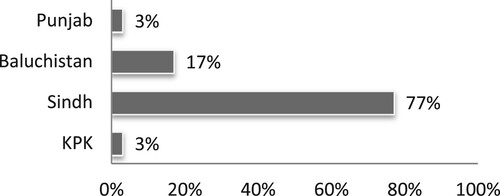
The government once launched a scheme, ‘Electricity for All’, that got abandoned practically and remained just a slogan. Buried in such an energy dilemma, RC has to adopt alternate means. Biogas is a mammoth breath of fresh air in this regard. Tons of animal and agricultural wastes make Pakistan’s biogas-based energy production a realisable dream. This paper presents the potential of biogas in rural Pakistan, the resources and barriers in the development of domestic biogas plants. A strong need of policy is highlighted that must be there to uproot the barriers in biogas promotion.
2. Literature review
This section presents a comparison of the current study against the present body of knowledge targeting the factors affecting biogas development in Pakistan. The potential of biogas and its adoption in Pakistan has been presented in many research efforts, focusing individual or a collection of parameters that affect the development of biogas technology in Pakistan. Jan and Akram Citation2018; Luo et al. Citation2021; Jan Citation2021 presented their studies focusing the willingness of RC towards the adoption of biogas. The authors performed analyses on a target region and presented their findings in a mathematical fashion as regard to the sensitivity of the adoption of biogas in RC for selected parameters. Arshad et al. (Citation2018) and Yaqoob et al. (Citation2021) presented their research encompassing the potential of biogas to uplift the electricity generation of Pakistan. The authors of both the research efforts claim that Pakistan can drive itself out of the energy crisis if the biogas potential of the country is fully utilised. Moreover, the authors claim that without government support, the realisation of the biogas development for electricity generation is impossible. Economic benefits and socio-economic characteristics coercing RC to adopt biogas have been presented in Abbas et al. (Citation2017), Yasmin and Grundmann (Citation2019), Yasar et al. (Citation2017), and Moli et al. (Citation2021). The authors present economic models that demonstrate the dependence of the economic development of RC on several factors. They are of the view that the adoption of biogas technology leads to economic prosperity at micro- and macro-level. The economic prosperity is linked to adoption which, in turn, is linked to the promotion of the technology. The research presented in (Abbas et al. Citation2017) can be regarded as the concrete base for the economic analysis of biogas technology in Pakistan. The research presents the economic and sensitivity analysis of the adoption of biogas technology in Pakistan. The methodology and the findings presented in the research are beneficial for various developing countries, including Pakistan. The role of social media in biogas development has been presented in (Wang et al. Citation2020). In addition to the moderating role of social media, the authors presented the environmental and health benefits of adopting biogas technology.
The present body of knowledge contains outstanding research in the field of biogas potential/adoption considering the case of Pakistan. It is important to state here that the current research effort presents a comprehensive analysis of the adoption of biogas among RC from the stand-point of rural community. Several factors that have not been discussed so far are linked to the factors already existing in the present body of knowledge e.g. it is a secondary question that why is RC reluctant to adopt biogas technology; the primary question is: do you know what biogas plant is? Poverty is a subsequent of ignorance. The current research effort highlights the root cause of the behaviour RC; in addition, the people of RC were educated with the economic and health benefits of biogas during the survey. Moreover, the positive survey findings from the biogas plant owner were conveyed as a motivation to those who were ignorant of the biogas plant or its positive effects. The current effort can be regarded as a comprehensive study that provides an insight into the potential of biogas and the organisational support available in Pakistan at one side of the balance and the barriers at the other side. Furthermore, a way forward is established stating the drivers that can prove to be fruitful for the adoption of biogas technology in Pakistan. The study can form concrete base for policy makers to address the issues at grass-root level.
3. Methodology
The methodology finds its roots in the grounded theory (Bryant and Charmaz Citation2019). The grounded theory is an excellent tool in conducting a qualitative case study as it is concerned with attitudes and interactions at individual and collective level (Belgrave and Seide Citation2019). The scope of grounded theory is wide enough to incorporate structured, semi-structured and unstructured interviews. Since the aim of the current research is to present the barriers in the adoption of biogas at grass root level considering the experiences and behaviour of RC through interviews; hence, the grounded theory is employed to acquire the in-depth knowledge and explore new perspectives.
Grounded theory provided flexibility to encompass modifications during the process of interviews, hence forming a concrete base for the research. The study is carried out in the following fashion:
A list of locations was formulated where biogas plants are functional. Unlike certain research efforts, the list of functional biogas plants from PCRET was useful; however, it does not contain a number of biogas plants that are on ground and functional e.g. biogas plants in the villages of Pakpattan and Mandi-Bahauddin etc.
It was planned to interview the people who did not install biogas plant-residing in the neighbourhood of those having biogas plant installed, to highlight the barriers. However, the scale was extended to add the views of those who had biogas plants at their premise, for motivation purpose. Moreover, the villages having no biogas plants were also visited to evaluate the awareness among RC.
The scale of interviews was further extended to incorporate the personnel related to health centres, typically defined as rural health centres for the evaluation of health benefits gained through the installation of biogas plants.
The questionnaire kept evolving with new additions at runtime; the respondents were majorly adults (men and women) and interviews were conducted face-to-face as RC is not exposed to social media, telephone etc. and many regions do not even have WIFI or mobile phone signals. However, those having an idea of biogas plant or its benefits (partially or completely) were asked about the source of information to assess the factor of awareness.
After consummating interviews and confirming the reliability of interviews through ‘R’, an analysis was performed on the collected data to categorise and grade the dormant barriers. The analysis of interviews and discussions revealed some important points that could form a mean of motivation for RC reluctant to install biogas plant. The flow of survey is depicted in .
4. Potential for domestic biogas
Livestock animals are present in every house of the RC. Around 30–35 million people own livestock animals (Gelani, Dastgeer, Umair, et al. Citation2018). The livestock census revealed 172.2 million animals that can produce 652 million kilograms of manure per day and 20 million tons of bio-fertiliser annually (Uddin et al. Citation2016). A single cow or buffalo can produce 2.5 m3 biogas daily. It is presented in Ragazzi et al. (Citation2017) that 2.5kWh can be produced from 1 m3 of biogas; therefore, a cow or buffalo can produce 6.25kWh of energy. Therefore, a domestic biogas plant fuelled with animal waste can easily fulfil energy requirements of a family. depicts the strength of families owning cattle and buffaloes from livestock census 2006 (Livestock Census Citation2006). The extrapolated are computed for the year 2016 as it is depicted in (“CitationFeasibility Study of Domestic Biogas”) that 2.3% and 3.2% increase is observed in every decade.
Table 1. No. of families owning cattle and buffaloes.
Pakistan’s economy highly depends upon its agricultural production. The agricultural sector contributes 21% to the Gross Domestic Product (GDP) (Azam et al. Citation2015). Almost every family in rural Pakistan is linked to agriculture directly or indirectly. The agricultural and animal wastes make the backbone of biogas plant. The estimated biogas power potential (in GW) of Pakistan through agricultural and animal waste is presented in .
Figure 4. Increasing potential of biogas in Pakistan (CitationPakistan Bureau of Statistics).
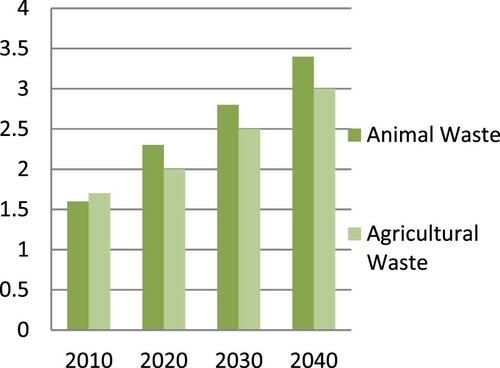
Domestic biogas installed at a premise costs almost PKR7000 per cubic metre for installation. The running and maintenance costs are almost negligible if the plant is operated in an efficient fashion. PCRET recommends two plants sized for domestic use i.e. 3 and 5 m3 (CitationPakistan Council of Renewable Energy Technologies). The biogas plants with fixed dome arrangement are highly recommended. The reason lies in their underground construction that leads to less maintenance for being less prone to damage but demands a professional and skilled construction to maintain gas pressure.
Temperature is an important parameter for the conversion of solid substrates into gas. The optimal temperature for the purpose is in the range of 28–36 degrees Celsius (Saravanan and Manikandan Citation2012). Pakistan lies in the temperature zone of mostly warm weather which is appropriate for biogas production. Punjab is the most populated province of Pakistan with 70 million rural natives making more than 50% of Pakistan’s total rural strength. The average monthly temperature of Punjab mostly remains around 30°C for most of the year (CitationPakistan Meteorology Department). The case of Sindh is almost identical to Punjab; Baluchistan is comparatively dry; however, the climate of KPK is favourable for biogas production during summer.
5. Organisations
To cope up with the prevailing energy shortage, the government of Pakistan has established several organisations and departments to develop renewable resources-based energy extraction. Government instigated biogas technology back in 1976; 1200 family-sized units were installed, but the programme didn’t gain much fame because of inefficient plant design. The energy needs were fulfilled by natural gas at the time and the biogas technology didn’t succeed because of a strong counterpart. After almost three decades when energy crisis gained maximum swing, the government decided to go for alternate options available. The ministry of environment under the shelter of government of Pakistan is keen in developing fuel and fertiliser from animal and agricultural waste. Various programmes were initiated to accomplish the difference between supply and demand through renewable energy resources. The huge potential of Pakistan for biogas was also explored. Biogas promotion programmes were initiated at commercial and domestic levels. The government felt the need for cooperation and coordination of private and academic sectors at micro- and macro-levels for the purpose. International companies from China, New Zealand and Netherlands showed keen interest in the development of biogas technology in Pakistan. UNDP Pakistan and NDO carried out a feasibility study of a widespread household biogas programme. The study was based on the availability of livestock animals, favourable temperature, land and water. Energy departments and associated degrees were introduced in the universities with the support of HEC to enhance the energy-based educational structure. The universities are playing their due role in the research and development of biogas technology. A summary of biogas organisations is pictorially presented:
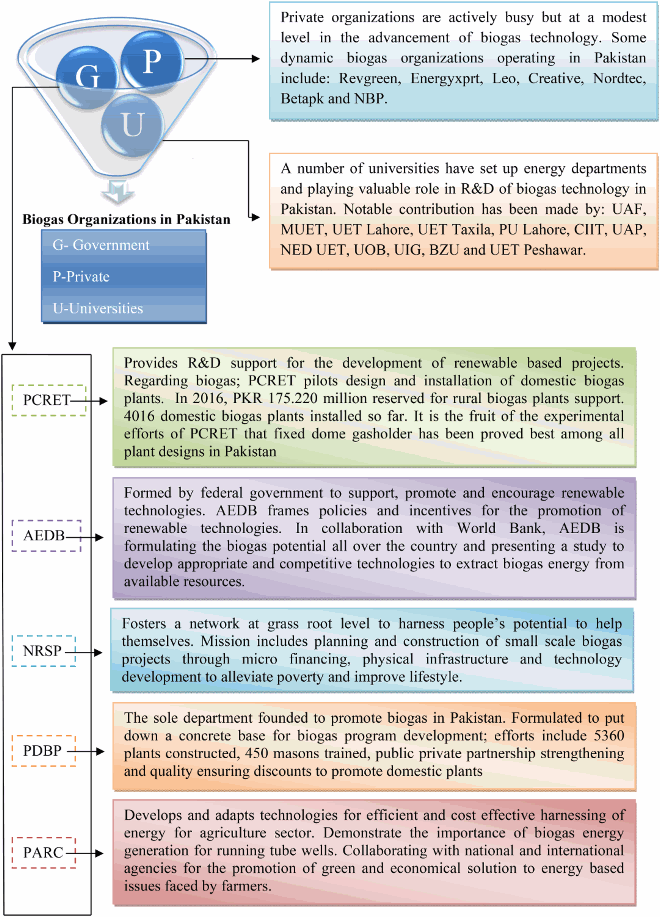
It is with the efforts of these institutions and organisations that 1200 biogas plants were installed in 2000, 4016 in 2002, 2500 in 2007, 556 in 2009, 5360 in 2014; and in 2016 Pakistan’s first commercial-sized biogas was set up in Okara and 500 (25 m3) plants were installed in 12 districts of Punjab (CitationRural Support Program Network Pakistan; CitationThe News International; Iqbal et al. Citation2018; Tareen et al. Citation2020).
6. Survey findings
6.1. Awareness
Only a paltry percentage (<10%) of RC owns a biogas plant
In the rest of 90%, more than 81% of RC has nickel and dime idea of biogas
Among those who are familiar with biogas plant, weighty percentage is of those who have personally seen/observed a biogas plant. However, the true knowledge of its benefits is trivial
Media participation in biogas advancement is almost negligible. presents the weights of stated sources of awareness of biogas among RC.
Institutional participation is limited; however, the role of PCRET and PDBP in developing understanding is significant among others, as depicted in .
Almost 41% people agreed to the installation of biogas plant at their premise when they were familiarised with its benefits. If installation finances are provided; this percentage may extend to 85%.
6.2. Reasons for not installing a biogas plant
People had mixed opinions for not installing biogas plant. In addition to the financial issues, the factor of dubiousness was observed that what would happen if plant fails or it does not meet its benefits? Some people mentioned financial issues and their unwillingness on the ground that they do not want to change their lifestyle. The future generations will also live the same way as their elders. Some other reasons were observed regarding the availability of land, but their proportion was quite shallow. The pictorial representation of the stated reasons with each weight is presented in .
6.3. Benefits of installing biogas plant
For those who own a biogas plant at their premise seemed quite contented.
Substantial reduction in workload and diseases is reported
Women are benefitted more than men and kids regarding workload and diseases
Reasonable financial savings are communicated as a result of biogas plant installation by saving from fertiliser cost, reduction in health expenditure and fuel cost.
It is revealed that the time used to spend on wood collection and making of dung cakes was employed on other income-generating activities.
Again the role of PCRET and PDBP is dominant as compared to other organisations in the development of domestic biogas installations. Most of the people got benefitted from PDBP’s financial assistances. The overall benefits of installing biogas plant are presented in .
7. Barriers
A pictorial representation of barriers against resources in the development of biogas revealed as a result of survey conducted in rural regions is presented.
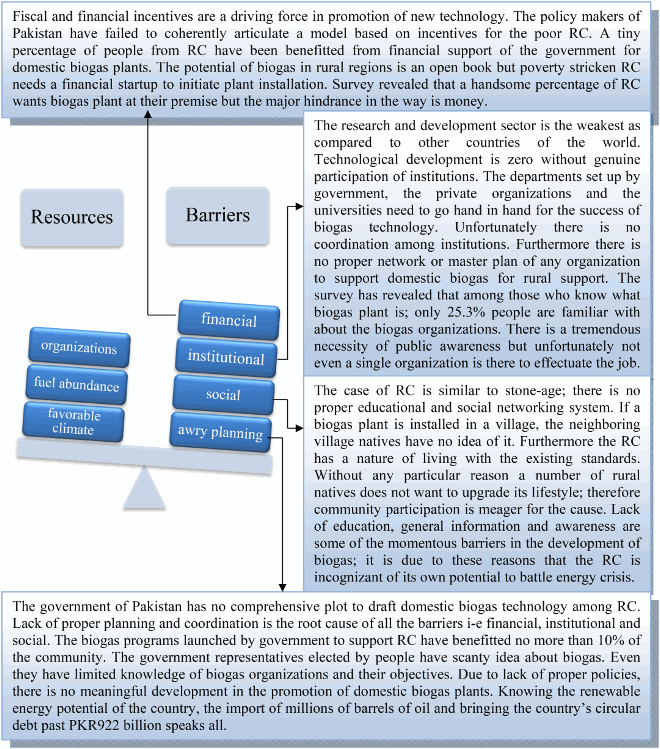
The following points formed the basis of balance:
Ignorance and no public awareness
Inconsiderable basic education among RC
Trivial print or electronic media; where media services are present, the media participation towards biogas is absent
Lack of proper framework for masons’ training or skill development centre
No academic or training institute established solely for biogas education
Non -existence of proper social networking system
Poverty and affordability issues
Dubiousness of RC; not able to take a penny at risk due to extreme poverty
Community participation issues
Nature of RC of living with existing standards; no craving for betterment or planning for future generations
Lack of proper government policies for rural support; no proper network for fiscal or financial assistance
Localised efforts by government; no general effort or policy devised yet. The emphasis of government is focused on particular districts only.
Inadequate incentives for public attraction
Profit -based private organisations
Inadequacy of well-defined policy for private sector participation by the government
Insignificant institutional participation
Negligible social participation and visits of university representatives for motivation and development of technical knowledge
Lack of interest of elected government representatives
8. Discussion and the way forward
The survey has revealed some major barriers in the development of domestic biogas technology among RC of Pakistan. A way forward to tackle these barriers is also presented.
8.1. Financial support-government policies
Poverty is one of the biggest challenges in the development of any positive cause. Pakistan has been facing this challenge right from the beginning. Referring to the financial hierarchy, RC is at the bottom of the system. For RC, it is extremely difficult to make both ends meet. During the survey, some people argued with the statement ‘how can we manage the capital cost of biogas plant, when we do not have resources to even provide food to our kids’. Indeed, biogas plant has the potential of bringing financial prosperity, but this is also true that to install a plant, initial investment is required which is not possible for RC to manage. Fortunately, the initial cost of domestic biogas plant can easily be returned from the savings of plant. Therefore, financial schemes must be established by public and private sectors with suitable rates of returns. Private companies can also benefit from providing initial investment and installation assistance; nominal rates of return in suitable time spans can easily be established so that business profit is achieved. The government efforts in providing financial assistance for domestic biogas plants are limited and localised. There is a requirement of devising absolute policies for rural support in a comprehensive fashion. Proper criteria and network should be established in providing loans/subsidies/fiscal/financial incentives for domestic biogas promotion. There is no proper coordination between departments and every department is working independently without the knowledge of the efforts of other departments. Cases have been observed where two separate departments have benefitted the same village twice. Some other village could have been benefitted if there is genuine collaboration between institutions. The public/ private partnership can also be very fruitful for the cause; the only requirement is genuine policy. The realisation of the importance of proper planning through alliance is the need of time. All the departments (AEDB, PCRET, NRSP, PBDP, universities, private sector) should be on the same page for the cause. Surveys should be conducted to monitor the potential of biogas and financial requirements of RC across the country. Reports should be established to verify the fruitfulness of the policies and amendments be made according to requirements.
It is important to state here that in 2013, the government of Punjab devised a policy of providing subsidy to the farmers for the installation of biogas plants (“CitationBiogas Supplemented Agri Tubewells”). Moreover, the government has taken an initiative of installing biogas plants and revising the existing energy policy considering huge potential of biogas which can be regarded as a major driver for biogas development in Pakistan.
An apparently deficient large-scale shift in government policy towards the installation of biogas plants, as a viable source of renewable energy, is also a barrier for the widespread use of biogas in Pakistan. For instance, under the umbrella of the multi-billion dollar China Pakistan Economic Corridor (CPEC) programme, both solar and wind power sites have been installed, in Pakistan (“CitationCPEC Energy Projects”). A policy/trend shift (which may require detailed feasibility studies as well) may lead to the installation of biogas plants in the country; CPEC info website (“CitationChina’s Biomass Tech”) mentions that biomass energy research from Lanzhou University of China is going to be introduced to Pakistan. A suitable push from the government's policy-making institutions can spur such an activity to support research and prototype development in this field and then facilitate widespread implementation.
8.2. Public awareness and technical support
After financial awareness, public awareness is the second major barrier for domestic biogas development in rural Pakistan. Social and educational structure is out of the questions among RC. In every government, since the establishment of Pakistan, ministers are appointed at federal and provincial levels for educational system development. Due to the lack of proper policies the educational system could not gain the required strength. The survey revealed ignorance of government representatives towards biogas. The elected members of the government at grass root level need to be educated first. How can funds be allocated and furnished by the government if its local representatives are unaware of biogas? Consequential mechanism is required to be coined by the government to educate its representatives so that they can actively participate and lead. As regards to academic institutions, community service is negligible. Domestic biogas development is the field where community service can be very beneficial. Students and teachers from educational institutes can play a vital part through regular visits to rural regions for spreading the knowledge of biogas benefits. For the purpose, community service must be made part of the curriculum at all educational levels. This will not only help in biogas development but also be instrumental in many other businesses of life. Primary educational institutes are present in rural regions but their condition is not up to the mark. The government should pay special attention in the development of the educational sector in rural regions. The addition of energy-based degrees in universities is undoubtedly a positive step, but the requirement of time is even more. Energy-related topics must be added to the curriculum at school level and at least primary education should be made free in rural regions. Moreover, there is a strong need of the establishment of technical training institutes for the purpose of technical awareness of RC. In developing awareness among public, media’s role cannot be ignored. The media participation towards the cause is inconsequential, whereas the requirement is consequential. Electronic media is limited in rural regions, but wherever it is present, media participation can be quite beneficial. Media must act as a channel between RC and institutional departments for social interaction, where the issues of RC can be addressed. Furthermore, media representatives should visit rural regions to cover the potential and requirement of biogas for its department’s assistance.
The positive impacts on health and workload reduction benefits should be conveyed to the RC as motivation towards biogas plants. Technical awareness can also be a beacon of light in this regard to persuade RC for biogas plant adoption. RC should be educated that their workload of dumping of manure can be reduced effectively and they will be provided with an efficient mean of waste disposal and utilisation.
8.3. RC’s nature-organisational support
This section could be part of financial or public awareness but considering its strength, it is dealt as an independent barrier. During the start of the survey, it was not imagined that there could be such an opposition to biogas development due to the mixture of dubiousness and stubbornness in the nature of RC. Although this nature has a support from poor financial condition and ignorance, it still needs a special and separate attention. Since every problem has a solution, a solution is there for this problem too. During the survey, an interesting event was told about a village where government employees came to install electrical equipment for electrification of the village. The natives gathered and opposed that installation with the statement that electricity is a hazard and we do not want to die of electric shock. This was due to the fact that natives only heard of people dying because of electric shocks but not electricity’s benefits and safe usage. Electricity was then made available in a part of that village and when the natives observed from their own eyes the benefits of electricity; they allowed installation in rest of the village. The same scenario appeared during biogas survey and a similar solution in the light of this event can be provided for biogas development too. This can be achieved by the participation of institutions from every sector. A healthy and informatory environment is the only necessity so that RC can be persuaded and motivated to adopt biogas at their premise. As far as competency and organisational support is concerned, people from health and environmental sectors should make visits to educate RC with health benefits of biogas. University representatives should make meeting with RC to spread technical knowledge and benefits of RC. Moreover, there is a need of devising economic policies and performing techno-economic research fruitful for RC; which can be achieved through organisational/institutional support. People from the financial/economic sector are also required to enlighten RC with financial benefits. In this way, people from every walk of life are required to play their role in mending RC’s thoughts, thereby upbringing RC lifestyle as a result of biogas adoption. With reference to the study presented for Bangladesh (Hasan et al. Citation2020), people with real ambition towards biogas technology implementation were ranked as the most influential driver towards biogas adoption. The case of Pakistan is almost similar. RC is hesitant of installing biogas plants; however, persuading RC through organisational and institutional support can drive Pakistan to the road of sustainability.
Last but not least, the pace on the road to success is always slowed by barriers on the way. It is impossible to achieve anything without knowledge, skill, determination and commitment. The exponentially increasing population, modern lifestyle of rich and industrialisation has led Pakistan to face a drastic energy situation. Poor is getting poor and with the passage of time deprived of basic rights. RC forms concrete base of Pakistan’s economic structure through agriculture. It is very unfortunate for this class to be driven to stone-age due to lack of proper policies. Now is the time for everybody to put personal interests aside and work on a collective level for the betterment of the country. Domestic biogas development is an element that can bring prosperity to RC. The resources are there, one thing that is needed is planning.
In fact, with suitable research, the field of biogas can receive a partner in the form of somatic energy harnessing power generation technologies such as those mentioned in (Al-Zamil Citation2017; Smith Citation2010). So, a combination of Animate Prime Movers research and biogas research can be an area of future research and technical development. Large farms of dairy animals can thus contribute not only to the food sector but also to the energy sector and that too, via dual technologies –i.e. biogas, which is the relatively mature technology, and the animate prime mover-based treadmills, which are lacking in research and development currently. Similarly, large equine farms can contribute to the national grid via biogas and via animate prime mover treadmills that can provide exercise to the horses (Dastgeer and Gelani Citation2020).
Moreover, for the specific case of equines, another interesting combination is setting up of equine farms in suitable city suburbs where these farms can provide Equine-Assisted Activities such as those mentioned in (Pelyva et al. Citation2020). In (White-Lewis Citation2020), the author mentions various positive consequences of equine-assisted therapy such as self-efficacy, well-being, pleasure and this list includes ‘sense of accomplishment’. This last point may be augmented via the inclusion of the activity of bio-gasification with the equines as its substrate source. The therapy clients can get an additional activity, besides grooming and caring for the horse – this additional activity can make them operate/feed the biogas digester and then a suitable measurement system can display how much energy is/will-be generated via the substrate which they fed to the digester. So, this can be an additional activity in the Equine-Assisted Activities list, which may provide ‘sense of accomplishment’ to the individuals involved.
9. Conclusion
Pakistan’s energy crisis still haunts the country. To quench energy demand a huge percentage of foreign exchange is eroded on oil imports which has cost the national economy dearly. There is a strong need to diversify the energy mix of Pakistan with inclusion of renewable resources capable of bringing energy prosperity to the region. Keeping in view the poor energy situation of RC and the potential of biogas, the adoption of biogas at domestic level seems fruitful. The study explores the willingness, acceptance and barriers in the adoption of biogas at domestic level in rural regions. The findings of the study reveal health and economic stability with biogas utilisation; in contrast, the places where biogas has not stepped foot, a strong inclination of people towards the adoption of biogas is felt if the financial support is provided. Almost all the barriers in people’s willingness and acceptance towards biogas adoption are directly or indirectly associated with poverty and ignorance. The institutional role towards the development of biogas is insignificant. The public and private institutions need to be on the same page for the cause. There is no genuine and comprehensive policy to familiarise people with the benefits of biogas and provide financial support for plant installation. A revolutionary step is expected from the government in devising proper policies for the betterment of RC through biogas. The time has reached when government has to set biogas development targets and provide healthy environment to encourage people from all sectors to play an effective part in domestic biogas deployment.
Disclosure statement
No potential conflict of interest was reported by the author(s).
References
- Abbas, T., G. Ali, S. A. Adil, M. K. Bashir, and M. A. Kamran. 2017. “Economic Analysis of Biogas Adoption Technology by Rural Farmers: The Case of Faisalabad District in Pakistan.” Renewable Energy 107: 431–439.
- Ahmad, Ali, M. A. Saqib, S. A. Kashif, M. Y. Javed, A. Hameed, M. U. Khan. 2016. “Impact of Wide-Spread Use of Uninterruptible Power Supplies on Pakistan's Power System.” Energy Policy 98: 629–636.
- Al-Zamil, S. 2017. “Mechanical Platform for Producing Clean Energy by Means of Animals.” Pat. WO2017061906A1.
- Anwar, Javed. 2016. “Analysis of Energy Security, Environmental Emission and Fuel Import Costs Under Energy Import Reduction Targets: A Case of Pakistan.” Renewable and Sustainable Energy Reviews 65: 1065–1078.
- Arshad, Naveed, and Usman Ali. 2017. “An Analysis of the Effects of Residential Uninterpretable Power Supply Systems on Pakistan's Power Sector.” Energy for Sustainable Development 36: 16–21.
- Arshad, M., I. Bano, N. Khan, M. I. Shahzad, M. Younus, M. Abbas, and M. Iqbal. 2018. “Electricity Generation from Biogas of Poultry Waste: An Assessment of Potential and Feasibility in Pakistan.” Renewable and Sustainable Energy Reviews 81: 1241–1246.
- Anam Azam, Fouzia Nazir, Muhammad Rafiq, Sobia Nazir, Sophia Nazir, and Shazia Tasleem. 2015. “Role of Agriculture in Economic Development of Pakistan.” International Journal of Business, Economics and Management Work 2 (2): 9–12.
- Belgrave, L. L., and K. Seide. 2019. “Grounded Theory Methodology: Principles and Practices.” In Handbook of Research Methods in Health Social Sciences, 299–316. Singapore: Springer.
- “Biogas Supplemented Agri Tubewells.” field.agripunjab.gov.pk.
- Bryant, A., and K. Charmaz, eds. 2019. The Sage Handbook of Current Developments in Grounded Theory. London: Sage.
- “China’s Biomass Tech to Ensure Energy Supply and Promote Agricultural Modernization.” http://cpecinfo.com/chinas-biomass-tech-to-ensure-energy-supply-and-promote-agricultural-modernization/.
- “CPEC Energy Projects.” Accessed July 6th, 2021. http://cpec.gov.pk/energy.
- Dastgeer, F., and H. E. Gelani. 2020. “Renewable Electric Power from the Equine Treadmill: An Evaluation of the Potential.” Advances in Science, Technology and Engineering Systems Journal 5 (5): 997–1006. doi:https://doi.org/10.25046/aj0505122.
- Farhodovna, A. M., and E. M. Abdishukurovna. 2021. “Application of the Law of Conservation of Energy in Economics.” The American Journal of Applied Sciences 3 (1): 93–103.
- “Feasibility Study of Domestic Biogas in Pakistan.” http://rspn.org/wp-content/uploads/2013/04/Pakistan-Biogas-Feasibility-Study.pdf.
- Gelani, H. E., F. Dastgeer, M. Umair, M. Umar, J. Hussain, and R. Danyal. 2018. “Uninterruptible Power Supply (UPS) in Pakistan: Effects and Way Forward.” In 2018 International Conference on Power Generation Systems and Renewable Energy Technologies (PGSRET), 1–6, September. Islamabad: IEEE.
- Gelani, H. E., F. Dastgeer, M. Umar, J. Hussain, R. Danyal, and M. Umair. 2018. “Economic Viability of In-House DC System in Pakistan.” 2018 1st International Conference on Power, Energy and Smart Grid (ICPESG), 1–4, April. Mirpur: IEEE.
- Gökgöz, F., and M. T. Güvercin. 2018. “Energy Security and Renewable Energy Efficiency in EU.” Renewable and Sustainable Energy Reviews 96: 226–239.
- Haider, Khadija, Muhammad Fahim Khokhar, Farrukh Chishtie, Waseem RazzaqKhan, and Khalid Rehman Hakeem. 2017. “Identification and Future Description of Warming Signatures Over Pakistan with Special Emphasis on Evolution of CO2 Levels and Temperature During the First Decade of the Twenty-First Century.” Environmental Science and Pollution Research 24 (8): 7617–7629.
- Hasan, A. M., M. A. Kabir, M. T. Hoq, M. T. Johansson, and P. Thollander. 2020. “Drivers and Barriers to the Implementation of Biogas Technologies in Bangladesh.” Biofuels, 1–13.
- https://www.iea.org/reports/global-energy-review-2021.
- Idrees, A. 2020. “Renewable Resources of Pakistan: Issues and Crisis.” International Journal of Renewable Energy and Its Commercialization 6 (2): 43–57.
- Iqbal, T., C. Q. Dong, Q. Lu, Z. Ali, I. Khan, Z. Hussain, and A. Abbas. 2018. “Sketching Pakistan's Energy Dynamics: Prospects of Biomass Energy.” Journal of Renewable and Sustainable Energy 10 (2): 023101.
- Irfan, M., Z. Y. Zhao, M. Ahmad, and M. C. Mukeshimana. 2019. “Solar Energy Development in Pakistan: Barriers and Policy Recommendations.” Sustainability 11 (4): 1206.
- Jan, I. 2021. “Socio-Economic Characteristics Influencing Farmers’ Willingness-to-Adopt Domestic Biogas Technology in Rural Pakistan.” Environmental Science and Pollution Research 28 (16): 20690–20699.
- Jan, I., and W. Akram. 2018. “Willingness of Rural Communities to Adopt Biogas Systems in Pakistan: Critical Factors and Policy Implications.” Renewable and Sustainable Energy Reviews 81: 3178–3185.
- Kalair, A., N. Abas, M. S. Saleem, A. R. Kalair, and N. Khan. 2021. “Role of Energy Storage Systems in Energy Transition from Fossil Fuels to Renewables.” Energy Storage 3 (1): e135.
- Kamran, M., M. R. Fazal, and M. Mudassar. 2020. “Towards Empowerment of the Renewable Energy Sector in Pakistan for Sustainable Energy Evolution: SWOT Analysis.” Renewable Energy 146: 543–558.
- Kanwal, S., B. Khan, and M. Q. Rauf. 2020. “Infrastructure of Sustainable Energy Development in Pakistan: A Review.” Journal of Modern Power Systems and Clean Energy 8 (2): 206–218.
- Kim, Kyeongseok, Hyoungbae Park, and Hyoungkwan Kim. 2017. “Real Options Analysis for Renewable Energy Investment Decisions in Developing Countries.” Renewable and Sustainable Energy Reviews 75: 918–926.
- Latief, R., and L. Lefen. 2019. “Foreign Direct Investment in the Power and Energy Sector, Energy Consumption, and Economic Growth: Empirical Evidence from Pakistan.” Sustainability 11 (1): 192.
- Latif, K., M. Y. Raza, G. M. Chaudhary, and A. Arshad. 2020. “Analysis of Energy Crisis, Energy Security and Potential of Renewable Energy: Evidence from Pakistan.” Journal of Accounting and Finance in Emerging Economies 6 (1): 167–182.
- Li, F. G., C. Bataille, S. Pye, and A. O'Sullivan. 2019. “Prospects for Energy Economy Modelling with big Data: Hype, Eliminating Blind Spots, or Revolutionising the State of the Art?” Applied Energy 239: 991–1002.
- Livestock Census. 2006. Agriculture Census Organization, Statistics Division, Government of Pakistan.
- Luo, B., A. A. Khan, M. A. S. Ali, and J. Yu. 2021. “An Evaluation of Influencing Factors and Public Attitudes for the Adoption of Biogas System in Rural Communities to Overcome Energy Crisis: A Case Study of Pakistan.” Science of The Total Environment 778: 146208.
- Mittlefehldt, S. 2018. “From Appropriate Technology to the Clean Energy Economy: Renewable Energy and Environmental Politics Since the 1970s.” Journal of Environmental Studies and Sciences 8 (2): 212–219.
- Moli, D. R. R., A. G. Hafeez, S. Majumder, S. Mitra, and M. Hasan. 2021. “Does Biogas Technology Adoption Improve the Livelihood and Income Level of Rural People?” International Journal of Green Energy 18: 10.
- Mughees, M., M. Sadaf, S. Khan, A. Rasheed, K. Daniel, and H. E. Gelani. 2020. “Impact of Shading, Dust Accumulation and Temperature Rise on the Performance of Solar PV: The Case of Pakistan.” 2020 International Symposium on Recent Advances in Electrical Engineering & Computer Sciences (RAEE & CS) (Vol. 5), 1–6, October. Islamabad: IEEE.
- NEPRA (National Electric Power Regulatory Authority), Pakistan. http://www.nepra.org.pk/industryreports.htm.
- The News International. www.thenews.com.pk.
- Pakistan Bureau of Statistics. https://www.pbs.gov.pk/content/agriculture-statistics.
- Pakistan Council of Renewable Energy Technologies. www.pcret.gov.pk.
- Pakistan Meteorology Department. www.pmd.gov.pk.
- Pelyva, I. Z., R. Kresák, E. Szovák, and ÁL Tóth. 2020. “How Equine-Assisted Activities Affect the Prosocial Behavior of Adolescents.” International Journal of Environmental Research and Public Health 17 (8). doi:https://doi.org/10.3390/ijerph17082967.
- Pereira, L. S. 2017. “Water, Agriculture and Food: Challenges and Issues.” Water Resources Management 31 (10): 2985–2999.
- Ragazzi, Marco, Manfredi Maniscalco, Vincenzo Torretta, Navarro Ferronato, and Elena Cristina Rada. 2017. “Anaerobic Digestion as Sustainable Source of Energy: A Dynamic Approach for Improving the Recovery of Organic Waste.” Energy Procedia 119: 602–614.
- Rural Support Program Network Pakistan. www.rspn.org.
- Saravanan, M., and K. Manikandan. 2012. “Experimental Study on Biogas Production in Batch Type Digester with Different Feed Stocks.” International Journal of Research in Environmental Science and Technology 2 (4): 132–135.
- Smith, A. R. 2010. “Bovine Treadmill.” Pat. US7654229B2.
- Tareen, W. U. K., M. T. Dilbar, M. Farhan, M. Ali Nawaz, A. W. Durrani, K. A. Memon, and M. Aamir. 2020. “Present Status and Potential of Biomass Energy in Pakistan Based on Existing and Future Renewable Resources.” Sustainability 12 (1): 249.
- Uddin, Waqar, B. Khan, Neelofar Shaukat, Muhammad Majid, G. Mujtaba, Arshad Mehmood, S. M. Ali, U. Younas, Muhammad Anwar, and Abdullah M. Almeshal. 2016. “Biogas Potential for Electric Power Generation in Pakistan: A Survey.” Renewable and Sustainable Energy Reviews 54: 25–33.
- Uribe-Toril, J., J. L. Ruiz-Real, J. Milán-García, and J. de Pablo Valenciano. 2019. “Energy, Economy, and Environment: A Worldwide Research Update.” Energies 12 (6): 1120.
- Urmee, Tania, and Anisuzzaman Md. 2016. “Social, Cultural and Political Dimensions of off-Grid Renewable Energy Programs in Developing Countries.” Renewable Energy 93: 159–167.
- Wang, Z., S. Ali, A. Akbar, and F. Rasool. 2020. “Determining the Influencing Factors of Biogas Technology Adoption Intention in Pakistan: The Moderating Role of Social Media.” International Journal of Environmental Research and Public Health 17 (7): 2311.
- Wang, B., Q. Wang, Y. M. Wei, and Z. P. Li. 2018. “Role of Renewable Energy in China’s Energy Security and Climate Change Mitigation: An Index Decomposition Analysis.” Renewable and Sustainable Energy Reviews 90: 187–194.
- White-Lewis, S. 2020. “Equine-Assisted Therapies Using Horses as Healers: A Concept Analysis.” Nursing Open 7: 58–67. doi:https://doi.org/10.1002/nop2.377.
- Yaqoob, H., Y. H. Teoh, Z. U. Din, N. U. Saba, M. A. Jamil, M. A. Mujtaba, and A. Abid. 2021. “The Potential of Sustainable Biogas Production from Biomass Waste for Power Generation in Pakistan.” Journal of Cleaner Production 307: 127250.
- Yasar, A., S. Nazir, A. B. Tabinda, M. Nazar, R. Rasheed, and M. Afzaal. 2017. “Socio-Economic, Health and Agriculture Benefits of Rural Household Biogas Plants in Energy Scarce Developing Countries: A Case Study from Pakistan.” Renewable Energy 108: 19–25.
- Yasmin, N., and P. Grundmann. 2019. “Adoption and Diffusion of Renewable Energy – the Case of Biogas as Alternative Fuel for Cooking in Pakistan.” Renewable and Sustainable Energy Reviews 101: 255–264.

